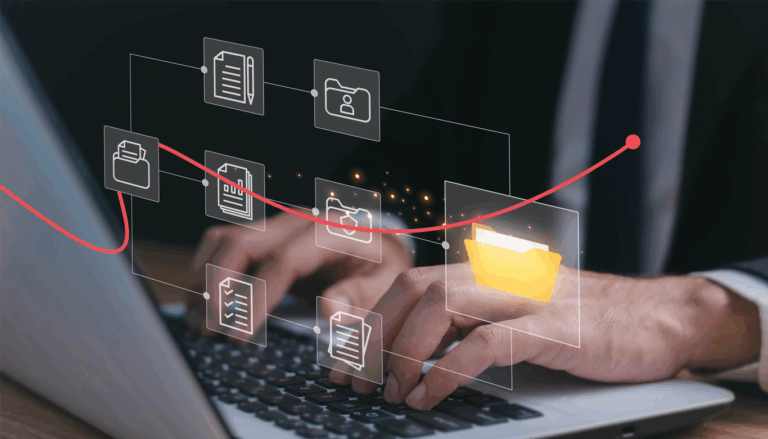Businesses constantly battle for a competitive edge in today’s dynamic digital landscape. Staying ahead relies on agility, speed, enhanced customer experiences and fostering a culture of innovation. Responding to market changes and business demands is not a luxury but necessary for survival and growth.
Migrating to SAP S/4HANA is often seen as the starting point for a digital transformation, a strategic move that can provide a competitive advantage.
However, it can be challenging. In addition to the technical aspects of digital transformation enabled by SAP S/4HANA, organizations must shift their mindset and embrace the new environment through change enablement.
Organizations need to be aware that SAP technical change is only half of the story in their SAP S/4HANA journey. A readiness to change and an ability to handle new business processes are the foundation for leveraging SAP S/4HANA to your advantage.
This 5-part blog series helps decision-makers navigate a successful digital and business transformation to SAP S/4HANA.
In this blog, you will learn:
- Why change enablement is crucial in an SAP S/4HANA migration
- How organizations can implement change enablement
- The foundation for a successful business transformation
- How Rev-Trac Platinum helps to accelerate and de-risk your journey to SAP S/4HANA

Getting users to accept and adapt to change is the foundation for a seamless transition to SAP S/4HANA
Shifting to SAP S/4HANA isn’t just an upgrade; it changes how your organization operates and gives you the power to do more with your data. However, an SAP S/4HANA migration can be a daunting prospect. It is a massive project with many IT and process-related challenges, especially for the unprepared. Organizations must also ensure that their employees adapt to and embrace the changes.
This is especially true for large organizations using SAP, where the rapid transformation of how we interact with systems and the modernization of how we work is changing the user experience. To meet the challenge head-on, we need to consider how change enablement can help ensure that business users can effectively engage with digital and business transformation.
Why change enablement?
The need for change enablement becomes clear when technical changes impact how business users do their jobs, which we call a business transformation. For example, when an organization upgrades from ECC to SAP S/4HANA as part of its digital transformation, it can significantly affect how users carry out business processes.
Even simple changes to the user experience (UX) can result in confusion and frustration for users, who may need to relearn how to carry out tasks they previously performed without issue. This lack of knowledge and understanding can result in problems and (costly) disruptions, such as users struggling to adapt to changes, productivity slashed, poor results, inconsistent work methods, and potential project failures.
To overcome challenges on their SAP S/4HANA journey, organizations should consider:
- Assessing the potential impact of the changes on users who interact with SAP systems
- A structured and phased approach to training delivery
- Establishing a mechanism to track and monitor user progress and completion of training for auditing purposes
- How to best equip users with the knowledge and skills to do their jobs in the new SAP S/4HANA environment
How change enablement solves issues
At its core, change enablement is about getting users to accept and adapt to change. Integrating a change enablement tool into a change management platform as part of a broader SAP DevOps initiative is crucial to a successful business transformation.
Rev-Trac Platinum, the SAP DevOps Platform, can accelerate your migration to S/4HANA without compromising your legacy ECC system as your new ERP environment is built and tested. The advantage of Rev-Trac Platinum is two-fold. It automates ABAP change management and integrates with third-party solutions to create a unified SAP DevOps platform. Organizations can automate the change process to ensure that all changes are tracked, tested, and approved before being deployed to production.
With the proper tools combined into a unified SAP DevOps platform, users will be aware of the changes and how they affect their day-to-day work.
Ensuring user readiness before implementation changes occur
For the best results, mapping communication about the functional enhancement into your SAP change delivery strategy is critical. When it comes to go-live, you should only consider a technical change associated with a change in business process as ready for production if the corresponding change enablement has been created. As a result, everyone receives the necessary training and education before deploying changes to production. Users are not left in the dark about the changes that have occurred, preventing issues affecting business processes.
Bottom Line: Managing change reduces frustration
Whatever industry, there is a risk that technical SAP change can severely affect product and performance. Business user change enablement should be a priority, without it, SAP changes can result in confusion and frustration for users. Mapping business transformation considerations into the technical transformation process, ensures that users are engaged, and remain confident and informed throughout periods of technical change.
In the next post, “Transform your SAP S/4HANA Migration with SAP DevOps”, I will discuss why adopting SAP DevOps is crucial when making technical changes.






